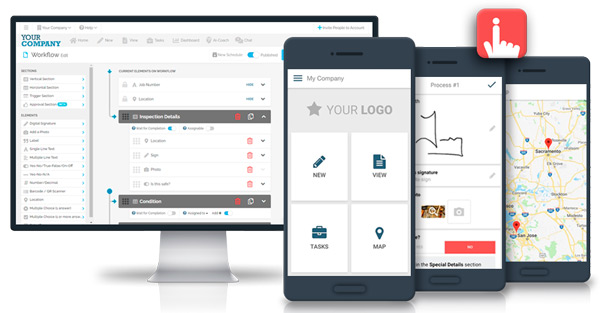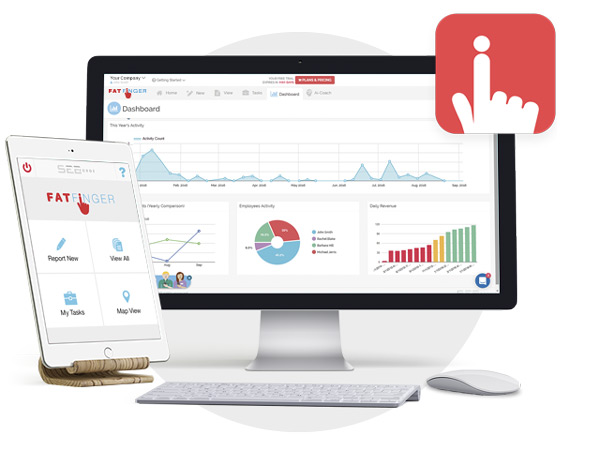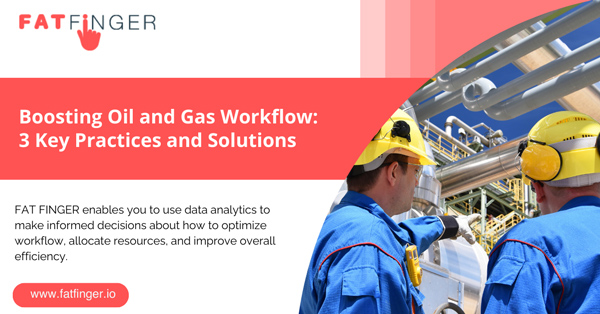When the first commercial well, The Drake Well, was founded in 1859, it was only a feedstock for kerosene.
In 1910, William Burton of Standard Oil helped propel gasoline sales to exceed those of kerosene.
Ever since, there has been tremendous growth in the oil and gas industry and companies are always striving to find new techniques to search for oil in more complex environments.
However, for an industry that has matured for over 150 years, oil and gas has failed to innovate as fast as other industries when thinking of modernization. Its focus has been on better hardware and improved oil pumping techniques, but not on oil and gas software.
Today, software is disrupting the oil and gas industry. Therefore, adopting digital procedures is the key to boosting oil and gas workflow.
Digitization will facilitate the adoption of modern practices and solutions to boost oil and gas workflow.
Fortunately, FAT FINGER offers the easiest and most flexible digital procedures in the world. You can build and deploy our enterprise-grade mobile app builder using an easy drag-and-drop no-coe builder.
“I’m glad we found such an efficient solution for our work order processes.Thanks to FAT FINGER, our workflow is now running smoother than ever before. Highly recommended!”— Emma Wilson, Continuous Improvement Specialist
Our oil and gas mobile applications will help you do the following:
- Establish standard operating procedures
- Implement a work management system
- Adopt lean management principles
These practices will help boost oil and gas workflow by directly tackling its challenges.
Understanding the Challenges of Oil and Gas Workflow
The 150-year evolution of the oil and gas industry has made its processes very complex. From exploration to extraction, transportation to refining, each phase is filled with technical, logistical, and environmental challenges.
These challenges continue to test the limits of efficiency and resilience.
In general, these challenges can be summarized into three items:
1 – Lack of Consistency and Efficiency in Work Processes
In the oil and gas industry, different teams or individuals may have varying approaches to performing tasks and procedures.
For example, during the drilling process, if there are no established standard operating procedures for well-control practices, each drilling team might employ different methods to handle potential well-control incidents. This lack of consistency can lead to confusion, delays, and increased risks.
As if that’s not enough, without standardized procedures, maintenance activities on equipment or facilities can vary across different locations or teams. For instance, routine maintenance checks on critical machinery may be performed differently resulting in inconsistent outcomes and potential equipment failures.
2 – Lack of Visibility and Coordination in Work Tasks
In a complex oil and gas operation, multiple teams, subcontractors, and stakeholders may be involved, each performing various tasks and activities. Without a robust work management system, it can be challenging to view the status of these tasks and ensure effective coordination.
Take a major offshore construction project for example, multiple contractors might be responsible for different aspects, such as laying pipelines, installing platforms, and hooking up equipment.
Without a centralized work management system, tracking the progress of each task, coordinating dependencies, and managing resource allocation becomes difficult. This results in miscommunication, delays, and increased costs.
3 – Waste and Inefficiency in Work Processes
The oil and gas industry involves complex operations with numerous interconnected processes. Without a focus on efficiency and waste reduction, various forms of waste can occur.
An example is excessive downtime during equipment maintenance and turnaround activities.
If there are inefficient work processes in place, such as delays in obtaining necessary spare parts, poor planning, or lack of streamlined procedures, they can result in extended equipment downtime. This leads to lost production, increased costs, and reduced operational efficiency.
Another example is waste resulting from overproduction or excessive inventory.
In a production facility, if there is a lack of effective demand forecasting and production planning, it can lead to overproduction and the accumulation of excess inventory. This ties up capital, consumes storage space, and can result in unnecessary waste if the inventory becomes obsolete.
These challenges are why we recommend adopting digital practices and solutions to boost your workflow.
Fun Fact: The oil industry uses a unit of volume called a ‘barrel’. The term originated in the early Pennsylvania oil fields, and the standard barrel of crude oil or petroleum product is 42 US gallons.
Essential Practices for Boosting Workflow

In 2013, Shell announced its plans to become the most innovative energy company in the digital field. And true to their word, they managed to integrate a digital oil and gas workflow into their operation.
As a result, an AVEVA report shows that the company was able to improve the operational performances of its off-shore projects, automate back-office operations, and improve route planning for the logistics vehicles.
Similarly, companies that follow Shell’s lead and continuously look for workflow optimization solutions can reduce operational costs, increase productivity, and foster a culture of continuous improvement.
Did You Know? Standard Operating Procedures (SOPs) aren’t unique to the oil and gas industry. They were initially developed by the military in the mid-20th century to ensure consistent, effective operations and have since become invaluable in complex industrial workflows.
Here’s how to do it: Establish standard operating procedures, implement a work management system, and adopt lean management principles.
1 – Establishing Standard Operating Procedures (SOPs)
Standard operating procedures are the cornerstone of consistency, safety, and operational efficiency in the oil and gas industry. These meticulously crafted guidelines provide a blueprint for complex processes, guiding workers through critical tasks and mitigating risks.
In an industry with high stakes and potential hazards, adhering to SOPs is paramount, fostering a culture of reliability, compliance, and continual improvement.
Using FAT FINGER’s easy and flexible digital procedures, it is easy for your frontline workers to implement your SOPs.
The best part is you only need to follow these five steps to establish your standard operating procedures:
- Identify processes and tasks. Identify the key processes and tasks within the oil and gas workflow that require standardization. This could include drilling operations, equipment maintenance, safety procedures, production monitoring, and logistics management.
Take a well-integrity management process for example, it involves activities such as well design and construction, integrity monitoring, repair, risk assessment, and decommissioning.
- Document current practices. This involves capturing step-by-step instructions, best practices, safety guidelines, and relevant documentation. Identify any gaps or inconsistencies that need to be addressed.
Case in point, a well-integrity management process will document the current well-integrity management practices, including procedures for well testing, regular inspections, maintenance activities, and reporting protocols.
- Standardize and improve processes. This step involves streamlining procedures, eliminating redundancies, and incorporating industry best practices. Ensure the revised processes align with safety regulations and industry standards.
For example, standardize the well-testing procedures, including the steps for conducting pressure tests, evaluating well integrity data, and maintaining accurate records. You can also Incorporate recommended practices from industry guidelines or regulatory bodies.
- Implement production management software: FAT FINGER provides a no-code builder that you can use to build applications that align with your workflow. Our software supports the creation, management, and accessibility of SOPs. And on top of that, it facilitates task assignment, progress tracking, and reporting.
Case in point, you can create mobile apps that allow for the creation and storage of digital SOPs, track the completion of tasks related to well integrity management, and provide real-time visibility into the status of activities.
- Train and communicate: Once you have created your enterprise-grade application, train your employees on the revised SOPs and how to use the application. Ensure that all relevant stakeholders understand their roles, responsibilities, and the importance of following the standardized procedures.
In the well-control case, for example, conduct training sessions for the drilling team and their personnel involved in well integrity management. Train them on the revised procedures, use of the production management software, and reporting requirements.
Now, this is important. Once you have set up your SOPs, encourage collaboration and feedback to refine the SOPs over time.
This can be facilitated by a work management system.
Top Tip: Embrace the philosophy of kaizen—continuous improvement. Use FAT FINGER’s platform to keep refining SOPs, ensuring ongoing operational excellence.
2 – Implementing a Work Management System
This will automate manual processes and improve coordination within the team.
Take Shell’s case for example, after they implemented an Enterprise Resource Planning (ERP) software, they were able to consolidate and manage essential business processes, such as finances, procurement, and logistics.
By centralizing these processes, they reduced errors and redundancy, leading to faster and more accurate decision-making.
Even more, FAT FINGER can help you integrate your facility operations with the ERP to create an efficient work management system.
Here’s how:
- Assess workflow and identify requirements. Assess the existing workflow and identify the specific requirements, identifying areas that can be addressed by implementing a work management system. This could include challenges related to task management, resource allocation, coordination, reporting, and data visibility.
For example, identify that the drilling operations require better coordination and real-time visibility into tasks, equipment availability, and progress tracking.
- Select an ERP software solution: SAP’s ERP is an example of an ERP software solution that caters to the specific needs of the oil and gas industry. It features such as task management, resource planning, scheduling, collaboration tools, reporting capabilities, and most importantly, it can integrate with our enterprise-grade mobile applications.
- Customize and implement the ERP system: Customize the chosen ERP software to align with your SOPs and configure it to meet the identified requirements. This involves setting up workflows, defining user roles and permissions, integrating data from various sources, and mapping existing processes onto the ERP system.
For example, you can configure the ERP system with our applications to include modules for drilling operations, equipment management, and task assignment.
FAT FINGER will streamline the process from drilling planning to execution, including assigning tasks to specific teams, tracking progress, and capturing relevant data.
- Train users and monitor performance: Provide comprehensive training to users on how to effectively utilize the ERP system for their daily work. Educate them on the features, functionality, and benefits of the system.
Monitor system performance and collect feedback from users to identify areas for improvement and address any issues or challenges that arise.
For example, conduct training sessions for drilling engineers, supervisors, and other relevant personnel on how to use the ERP software for task management, equipment tracking, and reporting.
By following this four-step process and implementing an ERP software solution tailored to the oil and gas industry, you can enhance task management and hazardous workforce management.
This improves workflow efficiency, reduces errors, and provides real-time visibility into operations for better decision-making.
The video below show the different workflow elements that can be created on FAT FINGER in seconds.
But wait, there’s more. Boosting oil and gas workflow requires more than just operating procedures and work management software.
You will need to overhaul your management principles by adopting lean management principles.
3 – Adopting Lean Management Principles
These remove waste, streamline processes, optimize resources, and encourage continuous improvement.
The management principles will help you create efficient workflows. You can then document these workflows on FAT FINGER.
FAT FINGER is a simple and easy-to-use solution that can help you document your operational excellence checklists.
By digitizing your business workflows, FAT FINGER allows for real-time decision-making and accurate data collection to help you analyze and improve your business operations.
Here are some lean management principles that an oil and gas facility can adopt to boost its workflow:
- Value stream mapping: Value stream mapping involves visually mapping the entire flow of materials and information required to deliver a product or service.
By identifying value-adding and non-value-adding steps, your facility can streamline processes and eliminate waste.
For example, in an oil and gas facility, value stream mapping can be used to analyze the flow of materials, information, and work tasks involved in drilling operations. It helps identify areas of waste, such as excessive waiting time between tasks or unnecessary movement of equipment, enabling the facility to optimize the drilling process.
Our enterprise-grade mobile applications allow you to visually map the entire flow of materials and information.
- 5s methodology: This methodology focuses on organizing the workplace to enhance efficiency and productivity.
It involves the following steps: Sort, Set in Order, Shine, Standardize, and Sustain.
In an oil and gas facility, this can include organizing tools, equipment, and work areas, implementing visual cues for easy identification, and maintaining cleanliness.
For example, applying the 5S principle to the maintenance department can lead to a well-organized inventory system, clear labeling of tools, and a clean and safe workplace, reducing time wasted searching for equipment and improving overall productivity.
- Just-in-Time (JIT): This principle aims to produce or deliver items in the right quantity, at the right time, and in the right place to minimize waste and inventory.
In an oil and gas facility, JIT can be applied to procurement and supply chain processes. By establishing strong relationships with suppliers, implementing efficient inventory management systems, and synchronizing production with customer demand, the facility can reduce excess inventory, minimize lead times, and optimize resource utilization.
- Kaizen (Continuous Improvement): Kaizen involves the philosophy of continuous improvement, encouraging employees at all levels to identify and implement small incremental improvements in their work processes.
This can lead to significant cumulative benefits over time. In an oil and gas facility, employees can participate in regular kaizen events to identify and implement improvements in safety procedures, equipment maintenance practices, or production workflows.
For example, a kaizen event can focus on reducing the setup time for drilling equipment, resulting in faster equipment readiness and increased productivity.
- Total Productive Maintenance (TPM): TPM is a proactive approach to equipment maintenance that involves operators in the maintenance process and maximizing equipment effectiveness. In an oil and gas facility, TPM can help reduce equipment downtime, improve reliability, and extend asset lifespan.
For instance, by implementing our preventive maintenance practices, and involving operators in equipment care and early problem detection, your facility can minimize unplanned equipment failures and increase overall equipment efficiency.
By adopting these lean management principles, your oil and gas facility can boost its workflow efficiency and foster a culture of continuous improvement, leading to improved operational performance and cost savings.
The table below compares how different areas in an organization perform before and after implementing the suggested practices and solutions.
| Area | Benefits Of Streamlining Processes And Communication | Drawbacks Of Maintaining Status Quo |
| Productivity | Increased productivity and efficiency | Lost productivity and inefficiency |
| Costs | Reduced costs and resources required | Increased costs and wasted resources |
| Communication | Improved coordination and collaboration | Miscommunications and coordination issues |
| Decision making | Better decision making through real-time data | Lack of data-driven decision making |
| Safety | Increased safety and compliance with regulations | Increased risk and potential safety hazards |
| Production results | Standardized procedures for consistent results | Inconsistent results and quality |
In a nutshell, establishing standard procedures, implementing work management software, and adopting lean management principles is the key to boosting oil and gas workflow.
FAT FINGER’s Data Analytics for Workflow Enhancement

In today’s digital age, the use of data analytics has become increasingly important in all industries, including oil and gas.
With vast amounts of data being generated every day, it is essential to leverage this data to gain insight into areas for improvement and boost workflows.
One significant benefit of data analytics for workflow enhancement is the ability to make data-driven decisions. By analyzing data, companies can identify bottlenecks, inefficiencies, and areas that need improvement.
At FAT FINGER, we are proud to have the easiest and most flexible digital procedures in the world.
Our platform enables you to use data analytics to boost your oil and gas workflow. It can be used to make informed decisions about how to optimize workflow, allocate resources, and improve overall efficiency.
Through our machine learning coaching, you can develop predictive models to anticipate equipment failures and other issues. This proactive approach can help reduce downtime and increase operational efficiency.
“We highly recommend FAT FINGER for anyone who needs to stay on top of machine maintenance.”—Patrick Davis, Maintenance Department Head
Using FAT FINGER, your frontline workers will be able to drag-and-drop digital procedures to create efficient workflow automation.
The table below provides a comparative analysis of key workflow metrics before and after implementing the FAT FINGER platform.
| Metric | Before FAT FINGER | After FAT FINGER |
| Operational Results | Poor production, quality, and safety | Improved production, quality, and safety outcomes |
| Operational Innovation | Inflexible systems, poor data usage | Enhanced flexibility, improved data-driven operations |
| Employee Engagement | Unengaged workforce, high turnover | Increased employee engagement, reduced turnover |
| Workflow Efficiency | Rigid and fragile operations | Streamlined processes with smart logic and active alerts |
| Data Analytics | Limited actionable insights | Real-time, valuable insights from data using AI |
| IT Integration | Overwhelmed IT teams | Efficient data exchange with existing systems through integrations |
Boost Your Workflow
Ultimately, boosting workflow is crucial for the oil and gas industry in order to remain competitive and efficient.
Understanding the unique challenges of the industry, and then implementing essential practices and solutions such as standard operating procedures, work management software, and lean management principles are all important steps in improving workflow.
Data analytics also plays a significant role in identifying areas for improvement and driving decision-making.
While implementation challenges may arise, commitment and consistency are key to successfully optimizing workflows.
Adopting FAT FINGER will help you implement all these solutions and boost your workflow.
“Gives people information right away, in real time. And provides transparency across the organisation.”—Laurie Campbell, Verified Customer
Share on LinkedIn:



